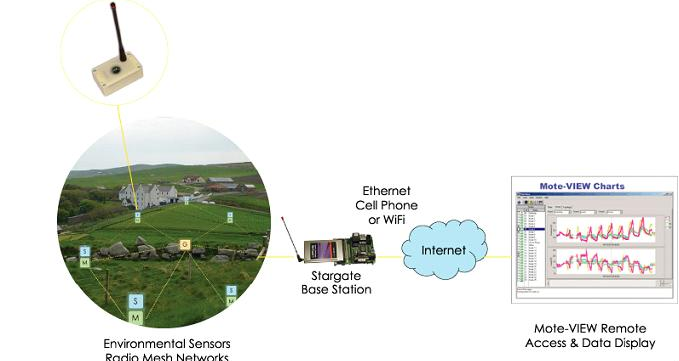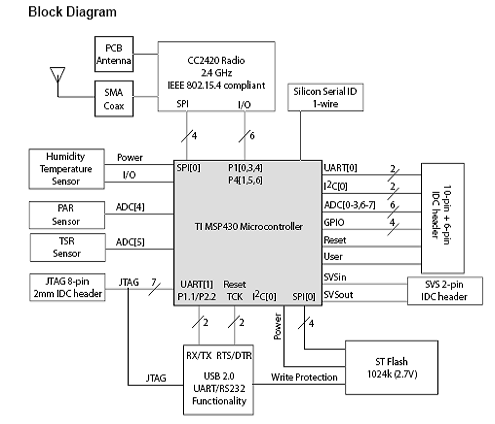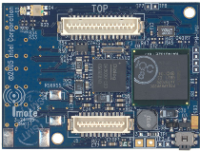Wireless sensor networks
My friend asked to publish this article.He does not have an account on Habré, but he really would like to get an invite.The author received an invite - axel2001. All the advantages to him.
Thanks for the invite - tar
I want to devote my article to the technology of wireless sensor networks (wireless sensor networks), which, I think, is unfairly deprived of the attention of the habr-community. The main reason for this, I see, is that the technology has not yet become widespread and for the most part is more interesting for academic circles. But I think in the near future we will see a lot of products, one way or another based on the technology of such networks. I have been researching sensor networks for several years, I wrote my PhD thesis on this topic and a number of articles in Russian and foreign journals. Also, I developed a course on wireless sensor networks, which I read at Nizhny Novgorod State University (I don’t provide a link to the course, if you are interested, I can give a link in private). Having experience in this field, I want to share it with a respected community, I hope you will be interested.

General information
Wireless sensor networks have gained a lot of development lately. Such networks, consisting of a multitude of miniature nodes, equipped with a low-power transceiver, microprocessor, and sensor, can connect the global computer networks and the physical world together. The concept of wireless sensor networks has attracted the attention of many scientists, research institutes and commercial organizations, which has provided a large flow of research papers on this topic. The great interest in the study of such systems is due to the wide possibilities of using sensor networks. Wireless sensor networks, in particular, can be used to predict equipment failure in aerospace systems and building automation. Because of their ability to self-organization, autonomy, and high resiliency, such networks are actively used in security systems and military applications. The successful use of wireless sensor networks in medicine for health monitoring is associated with the development of biological sensors compatible with integrated circuits of sensor nodes. But the most common wireless sensor networks received in the field of monitoring of the environment and living beings.
')
Iron
Due to the lack of clear standardization in sensor networks, there are several different platforms. All platforms meet the basic basic requirements for sensor networks: low power consumption, long operating time, low-power transceivers and the presence of sensors. The main platforms include MicaZ, TelosB, Intel Mote 2.
MicaZ
- Microprocessor: Atmel ATmega128L
- 7.3728 MHz frequency
- 128 KB flash memory for programs
- 4 Kb SRAM for data
- 2 UART's
- SPI bus
- I2C tire
- Radio: ChipCon CC2420
- External flash memory: 512 KB
- 51-pin add-on connector
- eight 10-bit analog I / O
- 21 digital I / O
- Three programmable LEDs
- JTAG port
- Powered by two AA batteries
TelosB
- Microprocessor: MSP430 F1611
- 8 MHz frequency
- 48 KB flash memory for programs
- 10 KB RAM for data
- UART
- SPI bus
- Built-in 12-bit ADC / DAC
- DMA controller
- Radio: ChipCon CC2420
- External flash memory: 1024 KB
- 16-pin additional connector
- Three programmable LEDs
- JTAG port
- Optional: Sensors of light, humidity, temperature.
- Powered by two AA batteries


Intel Mote 2
- 320/416/520 MHz PXA271 XScale Microprocessor
- 32 MB Flash Memory
- 32 MB of RAM
- Mini-USB interface
- I-Mote2 connector for external devices (31 + 21 pin)
- Radio: ChipCon CC2420
- LED indicators
- Powered by three AAA batteries


Each platform is interesting and has its own characteristics. Personally, I had experience with the TelosB and Intel Mote 2 platforms. Also, our own platform was developed in our laboratory, but it is commercial and I cannot talk about it in detail.
The most common 3 years ago was the use of the CC2420 chipset as a low-power transceiver.
Software and data transfer
The main standard for data transmission in sensor networks is IEE802.15.4, which was specifically designed for wireless networks with low-power transceivers.
There are no software standards in sensor networks. There are several hundred different data processing and transmission protocols, as well as node management systems. The most common operating system is the open source system TinyOs (being at Stanford University, I personally met one of the developers). Many developers (especially commercial systems) write their control system, often in Java.
The control program of the touch node under the control of the TinyOs operating system is written in the nesC language.
It is worth noting that due to the high cost of equipment and the complexity of setting up sensor networks, various modeling systems are widely used, in particular, the TOSSIM system, specially designed to simulate the operation of nodes under the control of TinyOs.
Conclusion
Sensor networks are becoming more common in Russia. When I started practicing them in 2003, the number of people in Russia who were familiar with this technology could be counted on the fingers. Including in Russia, the notorious Luxsoft Labs was engaged in this.
I have been working with sensor networks for 6 years and can tell a lot about these technologies. If the Habrasoobshchestvu is interesting and I have the opportunity, then I will be happy to write a series of articles on this topic. I can touch on such things as: real work with the TmoteSky platform, features of TinyOs programming in the nesC language, original research results obtained in our laboratory, impressions about 1.5 months of work at Stanford University, in a project on sensor networks.
Thank you all for your attention, I will be happy to answer your questions.
Source: https://habr.com/ru/post/95011/
All Articles